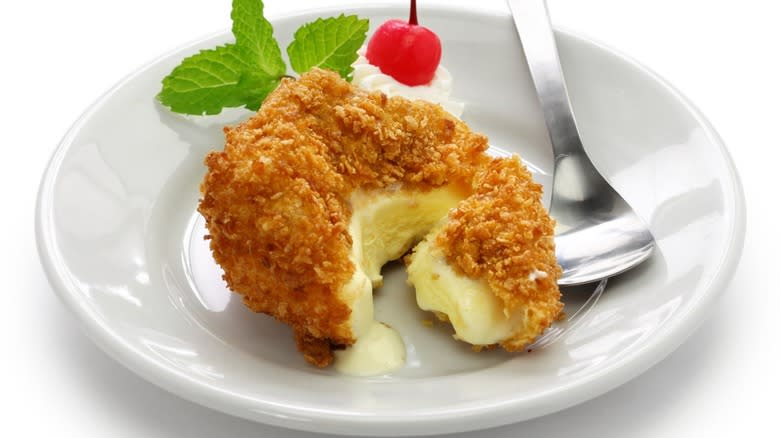Why It Pays To Add An Extra Coating When Making Fried Ice Cream

Most of us know fried ice cream as a classic Mexican dessert, yet the origin of this decadent treat is still up for debate. But one sure thing about fried ice cream is that it's one of the most delightful paradoxes of the culinary world — a frozen treat that's crispy and hot on the outside but deliciously cold and creamy on the inside. Achieving this perfect balance is an art and if you're looking to elevate the experience even further, an extra layer of coating can make all the difference.
The joy of eating a perfectly made fried ice cream ball lies in the contrast of textures. Biting into that crunchy coating followed by a sudden burst of a velvety core is the ultimate snack delight. And that is the secret behind adding an extra layer of coating — you amplify the textural contrast twofold, ending up with a pronounced and thicker crunch.
Read more: 25 Best Ice Cream Brands Ranked
An Extra Coating Creates A Marked Difference In Texture

The science behind it is rather simple. For the uninitiated, let's first unpack the purpose of the cereal coating on fried ice cream. The coating forms a protective barrier around the ball of the frozen dessert. As it's briefly plunged into hot oil, this outer layer rapidly cooks and hardens, preventing the ice cream inside from melting instantly. The thicker this barrier, the more insulation it provides, ensuring that the heat doesn't permeate too quickly. It also follows that the added thickness gives you more crispy goodness to enjoy.
To achieve this experience, once your ice cream ball has been coated in its cereal or cookie crumbs mixture and has set in the freezer, roll it once again in whisked egg whites and your desired crunchy topping then freeze. The second freezing solidifies this newly added layer, just like the first, while ensuring the innermost ice cream core remains chilled. Now quickly fry the dessert as usual and enjoy the escalated crunch.
Beyond the undeniable texture benefits, the double coating also allows for more flavor experimentation. You can play around with different cereals, cookies, or even nuts in your coating for delightful taste combinations that can be accentuated further with each added layer.
Read the original article on Tasting Table.

